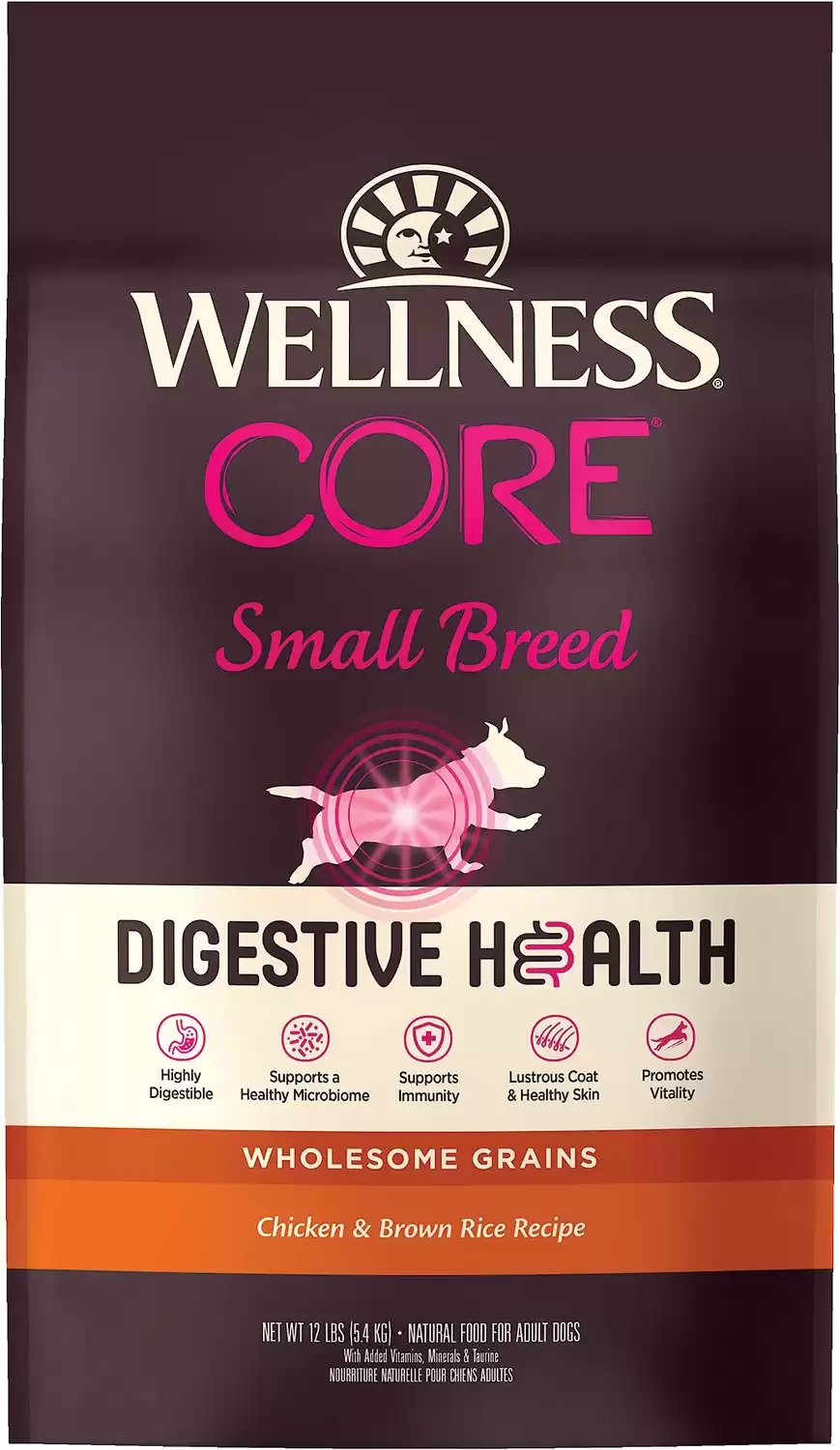Schnoodle
Advertisement
Schnoodle Scientific Classification
- Kingdom
- Animalia

Schnoodle Facts
- Diet
- Omnivore
Schnoodle Physical Characteristics
Schnoodle as a Pet:
- General Health
- Energy Level
- Shedability
- Trainability
- Intelligence
- Tendency to Chew
- Size
- Family and kid friendliness
- Yappiness / Barking
- Low
- Hypoallergenic
- Yes
- Separation Anxiety
- High
- Preferred Temperature
- Average climate
- Exercise Needs
- Moderate
- Friendly With Other Dogs
- Moderate
- Pure bred cost to own
- $2,000 to $3,000
- Dog group
- Toy
- Male weight
- 15-75 lbs
- Female weight
- 6-75 lbs
This post may contain affiliate links to our partners like Chewy, Amazon, and others. Purchasing through these helps us further the A-Z Animals mission to educate about the world's species.
View all of the Schnoodle images!
Schnoodles are very intelligent and may inherit the suspiciousness of their Schnauzer parent.
Schnoodles are a hybrid dog that is made by crossing a Poodle and a Schnauzer. Since Poodles come in three sizes (Toy, Miniature, and Standard), and Schnauzers also come in three sizes (Miniature, Standard, and Giant), there is a lot of variation in the size of this breed. Schnoodles can weigh between 6 and 75 pounds and can be between 10 and 26 inches tall.
See all of our expert product reviews.
These dogs may also be called a Miniature Schnauzer Poodle Mix. This breed is loving and loyal. They are also very intelligent and may inherit the suspiciousness of their Schnauzer parent. The appearance of a Schnoodle can vary based on the specific genes they inherit, and they may have a silky and wavy coat, a straight coat, or a curly coat. They can also be a variety of colors including black, black with white, gray, silver, apricot, or sable.
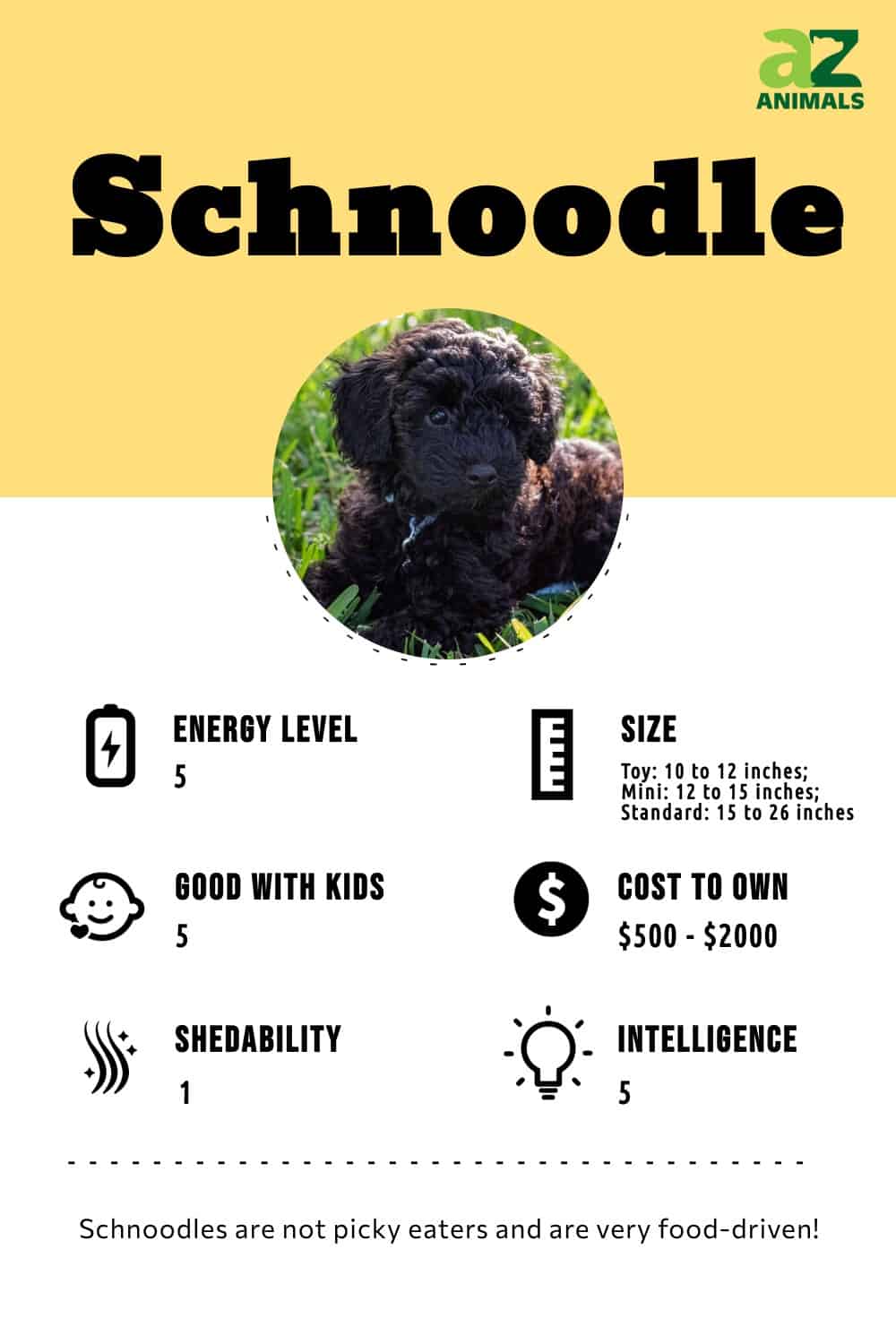
Origins Of The Schnoodle

Schnoodles are a fairly newer breed, first started in the 80s.
©Peter Turner Photography/Shutterstock.com
The Schnoodle was first bred in the 1980s when there was a growing popularity of cross-bred Poodles. In an effort to create a dog that was a family dog with a low rate of shedding, breeders crossed the Schnauzer with the Poodle. Since this is a crossbreed of dog, it is not recognized by any Kennel Club and there is no breed standard, although it may be registered in the American Canine Hybrid Club and the Designer Dogs Kennel Club.
3 Pros And Cons Of Owning A Schnoodle
| Pros! | Cons! |
| Low shedding: They don’t shed very much and can be a good choice for individuals with allergies. | Doesn’t do well when left alone: They do not like to be alone. They may bark or become destructive if alone for too long. |
| Kid-friendly: They are very friendly and can be a good companion for a child. | High energy: They are energetic dogs and will need regular exercise. |
| Good apartment dogs: They can be a good pet for individuals living in an apartment. | Stubborn: They can be stubborn, which can make them a bit more challenging to train. |
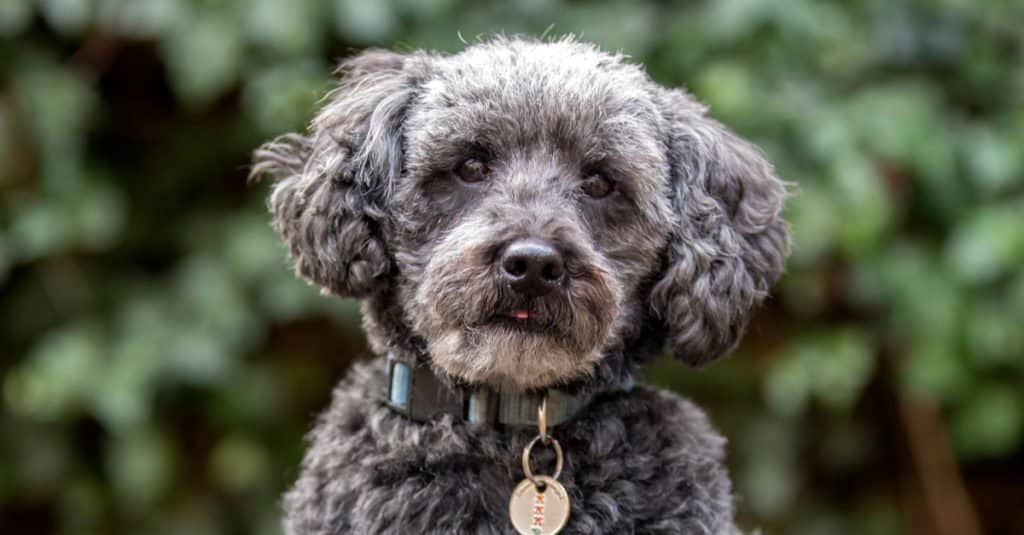
Schnoodles can be stubborn, which can make them a bit more challenging to train.
Health and Entertainment for your Schnoodle
See all of our expert product reviews.
©Edwin Butter/Shutterstock.com
Size And Weight
The size of a Miniature Schnauzer Poodle Mix varies based on whether a Toy, Miniature, or Standard Poodle and a Miniature, Standard, or Giant Schnauzer were mixed together. There are Toy, Miniature, and Standard Schnoodles. Toy Schnoodles are between 10 and 12 inches tall and weigh between 6 and 10 pounds, Miniature Schnoodles are between 12 and 15 inches tall and weigh between 13 and 20 pounds, and Standard Schnoodles are between 15 and 26 inches tall and weigh between 20 and 75 pounds. The exact mix of the genes from both parents will impact the dog’s final size.
| Height (Male): | 10 to 12 inches (Toy); 12 to 15 inches (Miniature); 15 to 26 inches (Standard) |
| Height (Female): | 10 to 12 inches (Toy); 12 to 15 inches (Miniature); 15 to 26 inches (Standard) |
| Weight (Male): | 6 to 10 pounds (Toy); 13 to 20 pounds (Miniature); 20 to 75 pounds (Standard) |
| Weight (Female): | 6 to 10 pounds (Toy); 13 to 20 pounds (Miniature); 20 to 75 pounds (Standard) |
Common Health Issues
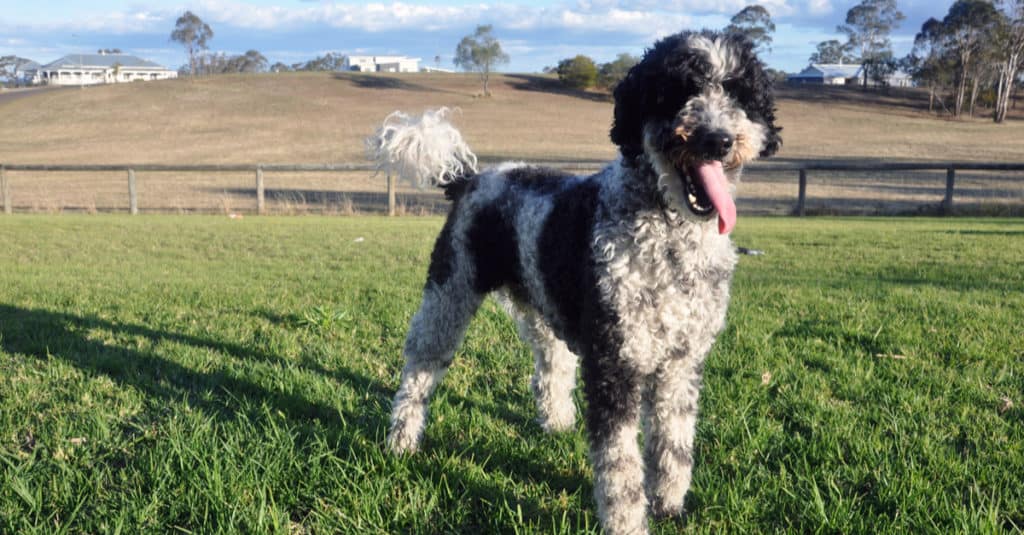
Schnoodles may develop Addison’s disease or epilepsy.
©Nicole Klein/Shutterstock.com
Before adopting or purchasing a dog of this variety, learn more about the potential health concerns they may face.
These dogs may develop Addison’s disease. This hormone deficiency can cause them to lose their appetite, vomit, or have diarrhea. Your veterinarian should be able to diagnose this condition and prescribe medication if needed.
Epilepsy is a seizure disorder that can cause a Schnoodle to lose consciousness or experience muscular convulsions. There isn’t a treatment, but your veterinarian may be able to make recommendations to help you manage the disorder.
Some dogs may also develop progressive retinal atrophy, which is a disorder in which the retina slowly deteriorates. Over time, it can lead to complete blindness.
In summary, a few common health concerns that a Miniature Schnauzer Poodle Mix may face include:
- Addison’s disease
- Epilepsy
- Progressive retinal atrophy
Temperament And Behavior
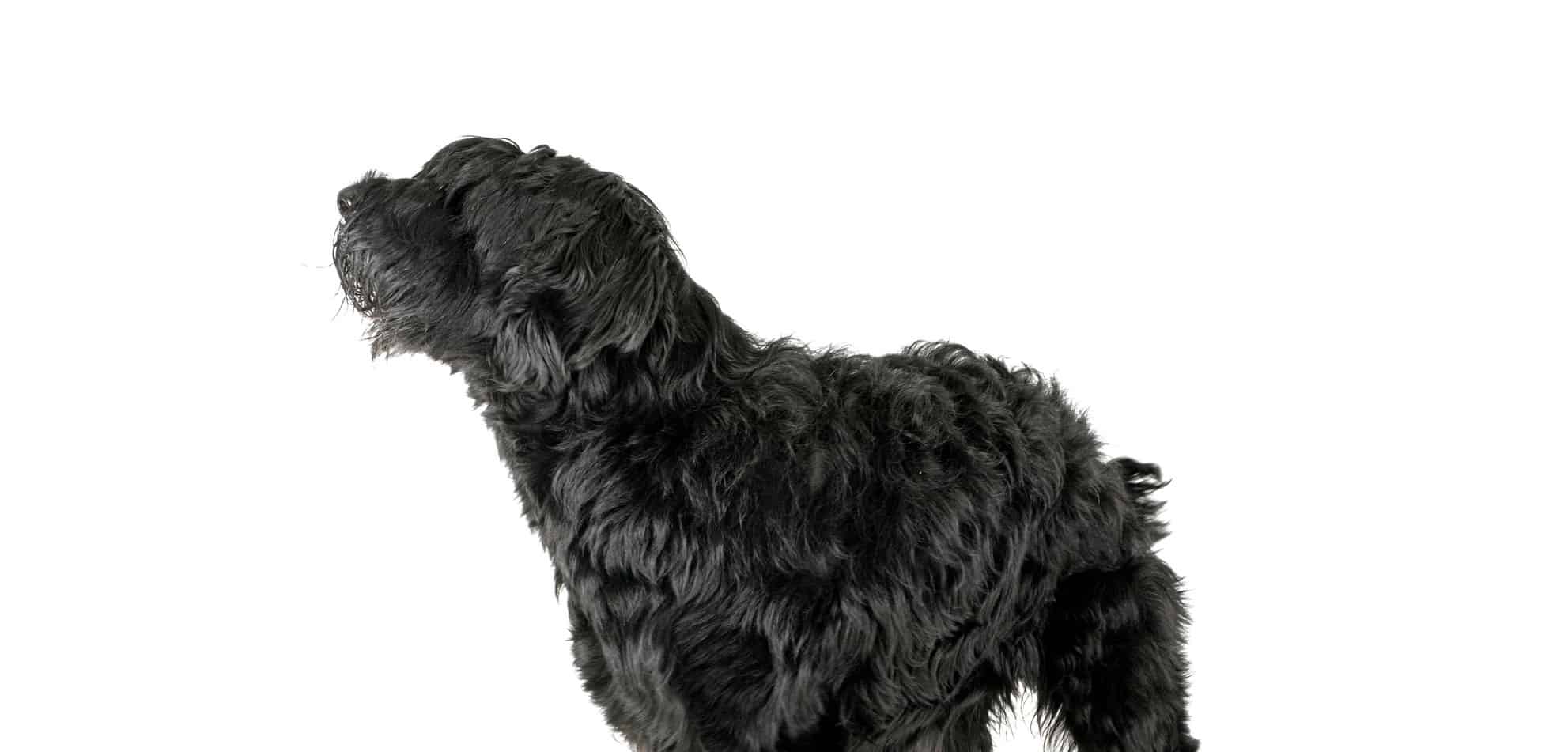
Giant Schnoodles have even temperaments and don’t require a lot of attention from their owners. Expect your dog to follow you around the house; if you reach down and pet them once in a while, they’ll be incredibly satisfied.
©cynoclub/ via Getty Images
The temperament of these dogs may vary quite a bit depending on whether a Miniature, Standard, or Giant Schnauzer was mixed with a Poodle, so there are a few pros and cons to weigh if you’re considering bringing home this hybrid breed. In general, most Schnoodles have very friendly and loyal personalities. Their traits allow them to make excellent watchdogs. However, since Giant Schnauzer tends to be more dominant and challenging to handle, some dogs may inherit these behaviors which can make them more difficult to control or train.
How To Take Care Of A Schnoodle
As you prepare to care for your pet, consider this breed’s temperament, dietary needs, exercise requirements, and health concerns to help you create the best care plan possible.
The Best Dog Food For Schnoodles
A Schnoodle’s size when fully grown will impact the ideal amount of food they should eat. Choose high-quality food and consult with your vet or the directions on the bag to determine the correct amount based on your pet’s activity level, age, and weight. You should also be aware of your breed’s specific health profile to find a food that meets your Schnoodle’s needs to help prevent health conditions. Puppies should also be fed high-quality puppy food. Keep in mind that puppies will need to be fed between three and four times a day because of their smaller stomachs.
Our choice at A-Z Animals for the best Schnoodle dog food is Wellness CORE Digestive Health Small Breed Dry Dog Food with Wholesome Grains.
Formulated with small breeds and sensitive stomachs in mind, this dog food has a plethora of probiotics to aid in comfortable, happy digestion. Digestive enzymes and omegas are vital for promoting immune health from the inside out. Plus, the recipe includes taurine which is important for Schnoodles’ eye health, since they can suffer from progressive retinal atrophy.
Find Wellness CORE Digestive Health Small Breed Sensitive Stomach Natural Dog Food here, on Chewy and Amazon.
- Chicken and brown rice recipe for small breeds
- Contains fiber-rich superfoods for healthy digestion
- Antioxidants and prebiotics for healthy immune system
Maintenance And Grooming
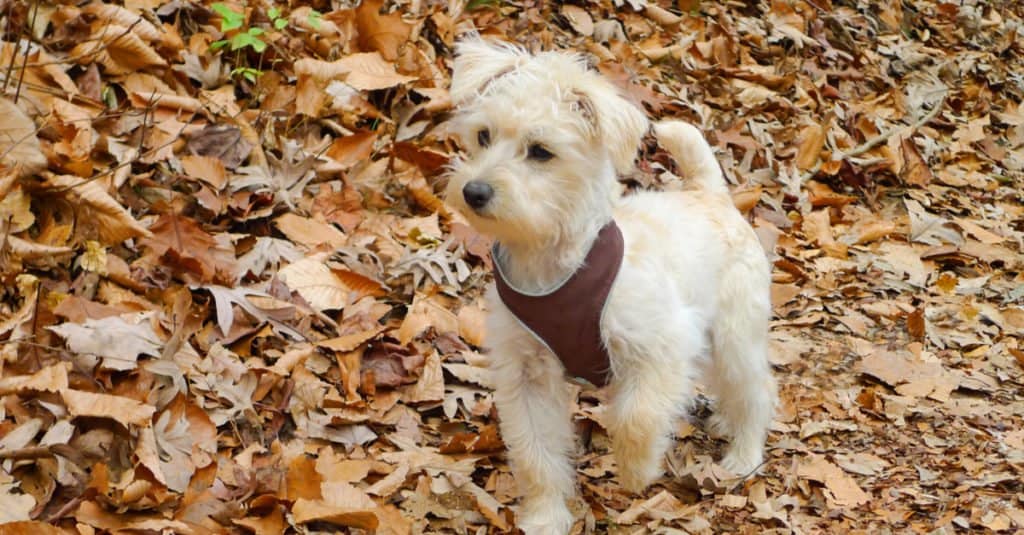
Schnoodles don’t shed very much and can be a good choice for individuals with allergies.
©Rena Schild/Shutterstock.com
The coat of a Miniature Schnauzer Poodle Mix can vary based on the mix of genes they inherit. They often have a wavy and silky coat, but they may also be curly or straight. These dogs will need to be brushed a few times each week and may need to have their coats clipped. Schnoodles shed very little to none at all and can be a good choice for allergy suffers. Keep in mind that your pet will also need to have their teeth brushed, nails trimmed, and ears cleaned regularly.
Training
While some Schnoodles may be a bit stubborn, this breed is generally easy to train. They are very intelligent dogs and tend to like the training process. Starting training from a young age, being consistent, and using positive reinforcement will be the most effective.
Exercise
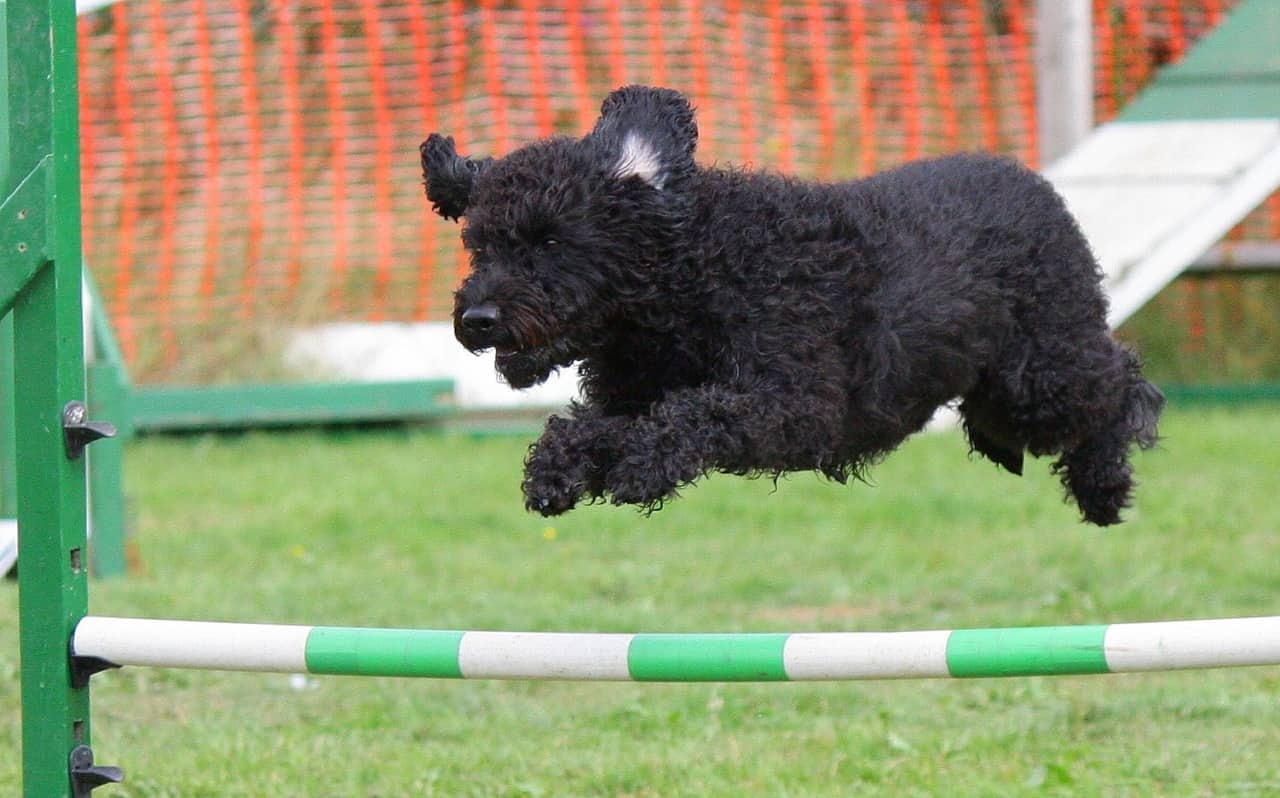
The Giant Schnoodle is a loyal, compliant, and intelligent dog that should need 60 minutes of exercise per day.
Schnoodles require a moderate amount of exercise each day. Taking your dog for one or two walks a day for a total of 30 to 60 minutes of exercise should be sufficient. Be sure to also offer play time in a yard and/or an assortment of toys in the house to play with.
Schnoodle Puppies
Training a Schnoodle while they are still a puppy is essential to help this breed learn expectations. Early socialization will also be necessary to help your pet learn how to act in different situations.
Before you bring your dog home, make sure your house is ready with food, a crate, a dog bed, toys, and other supplies. Create a safe, hazard-free space for your new pup to play and relax.
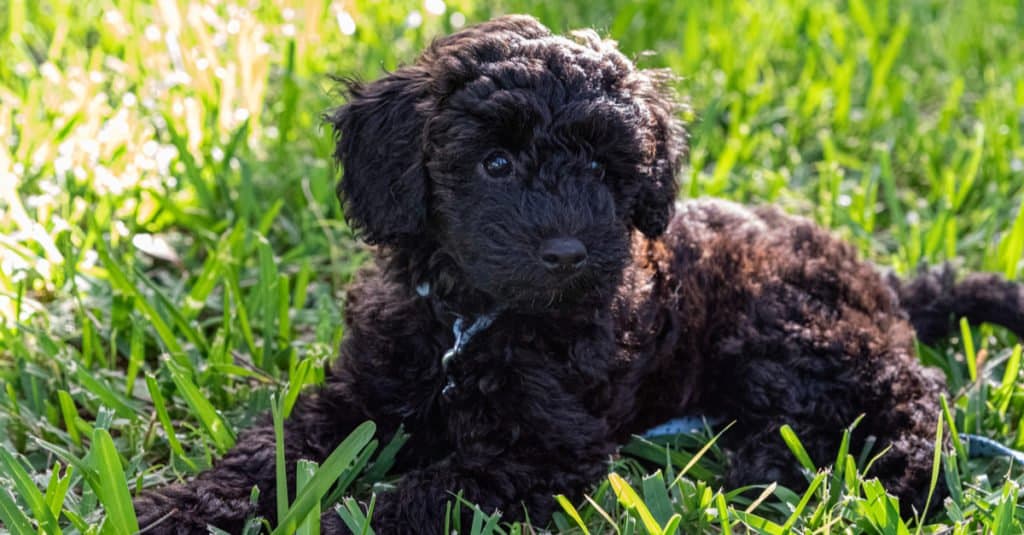
Schnoodles are energetic dogs and will need regular exercise.
©Peter Galleghan/Shutterstock.com
Schnoodles And Children
Most Schnoodles do very well with children. This breed is very affectionate and playful and can make a good companion and playmate for a child. It will be important to make sure children understand how to appropriately interact with a dog. Children, especially younger children, should always be closely supervised when around a Schnoodle or another dog breed.
Dogs Similar To Schnoodle
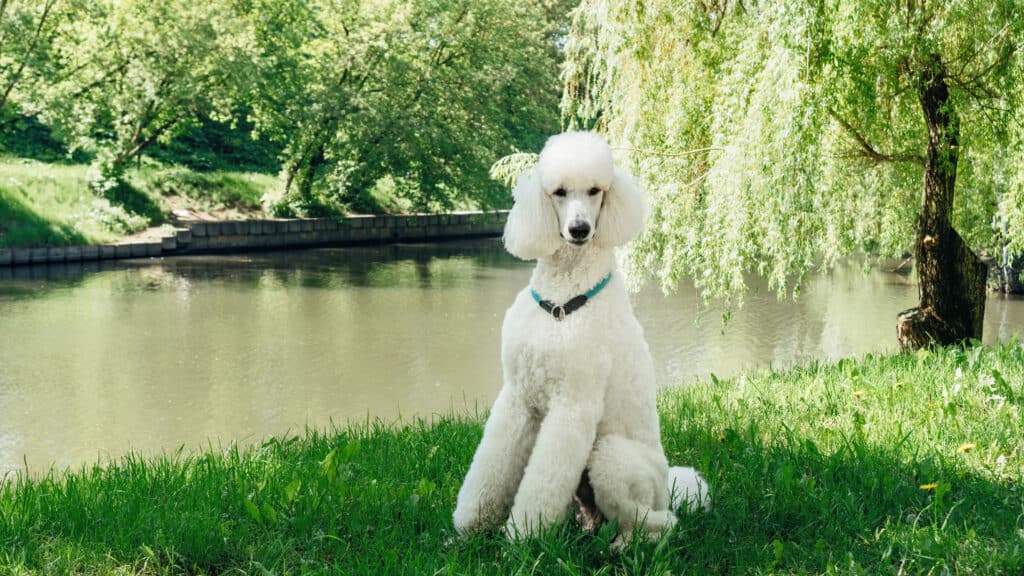
Poodles are friendlier with strangers than a Schnoodle.
©nieriss/Shutterstock.com
Poodles, Giant Schnauzers, and Maltipoos are three breeds that are similar to the Schnoodle.
- Poodles: Poodles and Schnoodles are both intelligent, playful, and affectionate. The smaller dogs are more vocal than Schnauzers and do better with other pets in the house.
- Giant Schnauzers: Giant Schnauzers and Schnoodles are both playful, territorial, and can make a good watchdog. Giant Schnauzers are larger than Schnoodles; they can weigh up to 105 pounds while the maximum weight of a Schnoodle is around 75 pounds.
- Maltipoo: Maltipoos and Schnoodles are family-friendly dogs with a high level of intelligence. Maltipoos are smaller than most Schnoodles with a maximum weight of around 20 pounds compared to the 75-pound maximum weight of a Schnoodle.
Famous Schnoodles
There are a few famous Schnoodles with celebrity owners or a growing Instagram following:
- Actress Claire Danes has a ‘famous’ Schnoodle named Weegee.
- Butters is a Schnoodle on Instagram. His owners love posting pictures of him enjoying the outdoors. He has over 3,000 followers.
Popular Names For Schnoodle
Need to find the perfect name for your Schnoodle? Read through the list below to find some inspiration:
- Bandit
- Bentley
- Humphrey
- Lucky
- Milo
- Bella
- Luna
- Precious
- Molly
- Katie
Schnoodle FAQs (Frequently Asked Questions)
How much does Schnoodle cost to own?
The cost to purchase a Schnoodle from a breeder is typically between $2,000 and $3,000. Adopting one from a rescue organization is significantly cheaper and generally costs between $300 and $500.
In addition to the cost to adopt or purchase the Schnoodle, you will also need to save money to cover their veterinary bills, food, and other expenses. This can cost between $500 and $1,000 or more each year you own the dog.
Is Schnoodle good with kids?
Yes, with proper socialization, a Miniature Schnauzer Poodle Mix can be a very good dog for families with children. They are loving, friendly, and playful.
How long does Schnoodle live?
Most Schnoodles live between 10 and 15 years.
What is a Schnoodle?
A Schnoodle is a mixed breed dog that is a cross between a Poodle (either Toy, Miniature, or Standard) and a Schnauzer (either Miniature, Standard, or Giant).
Do Schnoodles make good pets?
Yes, overall a Schnoodle can make a good pet. However, there are a few pros and cons to consider before purchasing a Schnoodle from a breeder or adopting one from a rescue. Schnoodles are very friendly and loving and can make a good family dog. However, they can also be stubborn and don’t like being left alone. So, this dog is best suited for an experienced owner who will be home with the Schnoodle most of the time.
Are Schnoodles hypoallergenic?
Yes, many Schnoodles may be hypoallergenic depending on the exact mix of genes that were inherited from their Poodle and Schnauzer parents.
Are Schnoodles aggressive?
No, Schnoodles are generally not an aggressive dog breed.
What's the difference between Schnoodles and Goldendoodles?
Schnoodles are poodle and schnauzer mixes, while goldendoodles are poodle and golden retriever mixes. Additionally, goldendoodles are friendlier than the alert schnoodle.
Thank you for reading! Have some feedback for us? Contact the AZ Animals editorial team.
Sources
- dogtime.com / Published February 20, 2021
- vetstreet.com / Published February 20, 2021
- dogs.lovetoknow.com / Published February 20, 2021
- thehappypuppysite.com / Published February 20, 2021
- dogbreedinfo.com / Published February 20, 2021
- people.com / Published February 20, 2021
- instagram.com / Published February 20, 2021
- petplace.com / Published February 20, 2021
- dogell.com / Published February 20, 2021
- dogell.com / Published February 20, 2021
- dogell.com / Published February 20, 2021
- welovedoodles.com / Published February 20, 2021





